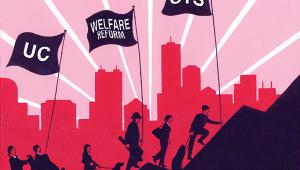The government boasts that it has held down council tax increases for four years in a row, but it’s ignoring the hikes faced by millions of low-income households following the move to local support schemes
The announcement that council tax in England is to rise by 0.9% in April makes 2014 the fourth year in a row that the annual increase has been held to less than 1%.
The rise in April works out at about £12 a year for the average tax payer. If council tax had simply kept up with inflation over this period, it would now be some 10% higher. Compared with inflation, the government’s determination to keep council tax down is saving the average council tax payer some £120 a year.
What has ensured that tax levels are held down is the requirement that any council wanting to put the tax up by more than 2% must secure the approval of its voters via a referendum. As a result, local tax payers have been spared the burden of cuts in council budgets. Or at least, most of them have.
At the same time, as government has successfully borne down on increases in overall council tax levels, it has shown little concern about increases in council tax for the very poorest households. These increases have come about as a result of the abolition last April of council tax benefit (CTB) and its replacement (in England) by council tax support (CTS).
CTB was a national (GB-wide) scheme invented by John Major’s Conservative government 20 years ago as part of the reconstruction of local government taxation in the wake of the poll tax. Under CTB, any household entitled to one of the four means-tested benefits automatically received a 100% discount on its council tax. Put another way, if you were poor enough to merit an income supplement benefit from the state, you didn’t pay any council tax.
This national scheme was abandoned last April and replaced by 326 different local schemes across England (the Welsh and Scottish governments having decided to continue to underwrite the old system). Of those 326, 58 opted to retain the old scheme with its 100% discount. The great majority of the others – 229 councils – opted to introduce a minimum payment of council tax regardless of how low a household’s income was.
As a result, we now estimate 2.2 million of the poorest families were affected with an average increase in their annual council tax of £139 last year. This is five times higher than the average increase that those living in the country’s most expensive properties faced (£28 a year or 55p a week). To be fair to the government, this is not a party political matter, the CTS schemes requiring minimum payments being the considered choice of councils of all political complexions.
Unlike CTB, which changed very little during its life, CTS schemes can be amended every year. So this council tax increase for low-income households can change each year too, and with no 2% cap. Next week the Joseph Rowntree Foundation will publish the New Policy Institute’s report detailing what these changes will be.
The full details of all 326 schemes, as well as our estimates of the numbers impacted, will be available at counciltaxsupport.org from the first week of April.
With a least some of those 58 councils now abandoning their CTB schemes (along with several others increasing the minimum payment), it is clear without having to go into the detail that the pattern seen last year will be repeated this year, namely that the biggest increases in council tax payable in April will be suffered by some of the poorest households in England.
Peter Kenway is director and co-founder of the New Policy Institute. This post first appeared on the NPI Blog










